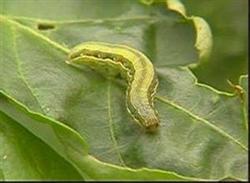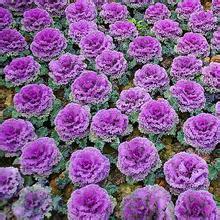How to control cabbage armyworm

Cabbage armyworm (cabbage moth) is alias cabbage night burglar, cabbage armyworm, Latin name: Mamestra brassicae Linnaeus belongs to Lepidoptera, Noctuidae. Cabbage night moth has a variety of feeding habits, with more than 100 species of hosts in 45 families. The main vegetables are cabbage, cauliflower, cabbage, radish, rape, eggplant fruits, legumes, melons, potatoes and so on. The damage characteristics of newly hatched larvae gathered on the back of leaves, gnawed on the mesophyll and remained the upper epidermis. The 2th instar scattered the damage and ate the leaves into holes. After the 4th instar, they came out to overeat at night, leaving only leaf veins and petioles. The aged larvae could eat up the crops and migrate to the neighboring fields in groups. Older larvae have the habit of drilling, often drilling human leaf balls or cabbage heart, excreting feces, and can induce soft rot to cause rot, so that vegetables lose commercial value. Morphological characteristics: the adult is 25 mm long and has a wingspan of 45 mm to 50 mm. Grayish brown, the front wing has a gray-black ring pattern, gray-white reniform pattern, the front edge near the end has three small white spots, the sub-outer edge line is white and thin, along the outer edge there are a row of black spots, rear wing gray, no markings. ovoid, with a diameter of 0.6-0.7 mm, with radial trigonal longitudinal ribs, with transverse septum, yellowish-white at birth, purple-black before hatching. The body length of the last instar larvae of larvae is 29.1mm, the newly hatched larvae are black-green, and the later body color is variable, ranging from light green to black and brown. The body is obviously segmented. The topline and subtopline are white dotted thin lines, the valve line and the lower valve line form a gray-white broadband, and there are black stripes on both sides of the back, showing an inverted eight-shaped shape. The 1st and 2nd instar larvae lack the first two pairs of abdominal feet and walk like inchworm. pupa is about 20 mm long, reddish brown or dark brown, with a dark longitudinal band in the center of the back, long gluteal spines, 2 long spines, and the thorn end is spherical. The living habits of cabbage armyworm occurred in 1 generation in Xizang, 2 generations in Gansu (Jiuquan), 2 generations in northeast and northwest, 3 generations in Liaoning (Xingcheng), North China, Central China and East China, and 4 generations in Sichuan (Chongqing), Hunan and Shaanxi (Jinghui). The overwintering pupae were mostly under the host plant Honda, field edge weeds or field stalks. From March to June of the following spring, when the temperature rose to 15: 16 ℃, the adults emerged unearthed, most of them were irregular, and the emergence period was longer. The adults sleep during the day and go out at night, and the activity peak is in the middle of the night. the adults have chemotaxis, strong phototaxis to molasses and weak phototaxis. The phototaxis of female moths are higher than that of males. Female moths mate once in a lifetime, and their eggs are mostly laid on plants with luxuriant leaves and thick green leaves. The egg monolayer is located at the back of the middle and lower leaves, with 60-150 eggs in each piece. In general, the life span of female moths is 5ml for 10 days, with a maximum of 3000 eggs, with a life span of 500ml and 1000 eggs. The optimum temperature for egg development is 23.5-26.5 degrees Celsius, and the duration is 4MUR 5 days. After 3 years old, the eggs disperse and form holes in the leaves. After 4 years old, they hide in the topsoil near the leaves, heart leaves or host roots during the day, and come out to feed at night, but when the plant density is high, they are not hidden during the day. The leaf balls of cabbage and cabbage were damaged after 3 years old. The food intake increased after 4 years old, and the food intake of 6 years old was the largest, accounting for 80% of the total food intake. The optimum temperature for larval development is 20-24.5 degrees Celsius, and the duration is 20-30 days. When the larvae mature, they can pupate in the soil of 10cm topsoil, the pupal period is generally 10 days, the oversummer pupa period is about 2 months, and the overwintering pupa can reach more than half a year. Cabbage armyworm prefers warm and high humid climate. the average daily temperature is 1825 degrees Celsius and the relative humidity is 70% 80%. The temperature is lower than 15 degrees Celsius or higher than 30 degrees Celsius, and the humidity is lower than 65% or higher than 85%. Cabbage armyworm is an intermittent local pest that often breaks out in spring and autumn within a year. cabbage armyworm natural enemies egg parasitoids include Trichogramma, Trichogramma, etc.; parasitic wasps in larval stage include cabbage armyworm parasitoids, armyworm parasitoids, polyembryonic wasps of Spodoptera litura, and large leg wasps in pupal stage. Predatory natural enemies such as beetles, tiger beetles, ants, wasps and spiders also play an important role in the larval stage. According to the investigation in Chongqing, walking worm and single-branch fungus are one of the main factors to inhibit the second generation larvae. Agricultural control vegetable field harvest after ploughing in autumn or winter ploughing deep, uprooting weeds can eliminate part of the overwintering pupae, combined with agricultural operations, timely removal of eggs and leaves gathered by the first instar larvae, centralized treatment. 2. Trapping and killing adults make use of the phototaxis and chemotaxis of adults, setting up black light or sweet and sour pots during the emergence period (the ratio of sugar, vinegar, wine and water is 10, 1, 1, 8 or 6, 3, 1, 10). 3. The first biological control is to apply the bacterial insecticide Bacillus thuringiensis: Bt suspension agent and Bt wettable powder before the 3rd instar of the larvae, generally containing 10 billion spores per gram and spraying water 500 to 1000 times. The effect of spraying in sunny days is better when the temperature is above 20 degrees Celsius. Second, Trichogramma was artificially released every 667 square meters, setting up 8 spots every 667 square meters, each time 2000 million 3000 heads per point, once every 5 days for 2 consecutive 3 times. 4. Chemical control should be carried out when the larvae before the 3rd instar are concentrated and the food intake is weak to . The commonly used medicament and dosage refer to Pieris rapae. The types of drugs are also selected to eliminate 2000 times and hit 2500Mel 3000 times. If you miss one or two larvae, you can choose 2000 times spray to control the mites. In order to prevent the occurrence of drug resistance, pesticides should be used alternately. There is no need for mixed use of multiple pesticides or continuous use of single pesticides. The amount of water must be sufficient and the spray is evenly in place.
- Prev

Cultivation techniques of purple cabbage in spring
Purple cabbage has good cold resistance, compact heading, bright color, strong adaptability, high yield and good quality. it is suitable for cultivation in open field and protected field, with a yield of 2500-3000 kg per mu. 1. Variety selection: Zigan No. 1, Zaohong, Hongmu and other varieties with strong winter and early spring sowing were selected. 2. Sowing and raising seedlings: Nanjing.
- Next

Prevent cabbage cracking in early spring
Cabbage in the protected field in early spring is prone to leaf ball cracking, which not only affects the appearance quality and commerciality of cabbage, but also is easy to be infected with diseases, affecting storage and transportation. According to the experiment, the 20-blue crack ball is not only related to variety, but also related to too much water, but has nothing to do with fertilizer. If the water is insufficient, the cabbage is small, if the water.
Related
- Where is it suitable to grow horseradish in China? it is expected to see the middle altitude horseradish in Alishan.
- How to prevent tomato virus disease reasonably? (Control methods included)
- Many people like to plant towel gourd on the balcony. What are the main points of this method and management?
- What crops can chili peppers be mixed with?
- Fertilization techniques and matters needing attention in Tomato
- What are the grafting techniques for peach seedlings in spring?
- Harm and control methods of root swelling disease of Chinese cabbage
- What are the pests of sweet potatoes? How to prevent and cure it?
- Symptoms, causes and Control methods of navel Rot in Tomato
- The cause of "Cucumber rotten bibcock" in Farmers' planting Cucumber and its Control Plan

